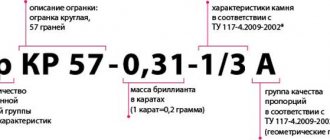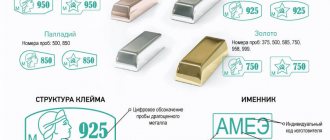Jewelry products have their own specifics in the field of mandatory labeling . to such a product , and applying an identification code directly to the product requires special equipment.
In this article we will tell you which jewelry items are subject to mandatory labeling , what equipment will be needed when working with this group of products , and by what time market participants need to prepare.
What is jewelry marking
Marking involves applying two-dimensional DataMatrix codes to gold, palladium and platinum products, which are read by a scanner and contain complete information about the product and about each stage within the cycle of transition from manufacturer to retail owner.
The introduction of labeling is intended to protect buyers from falsification and fraud. The state is striving to get rid of the shadow market and unscrupulous entrepreneurship - both in the field of selling synthetic counterfeits and smuggling, and in terms of inflating the cost of sold jewelry. Labeling also allows full access to information and thereby simplifies the work of supervisory authorities.
Labeling deadlines
Mandatory labeling in the jewelry industry was supposed to start at the beginning of 2021, but market participants were not ready for the new requirements, and the deadline had to be postponed.
The new deadlines are determined by Decree of the Government of the Russian Federation of February 26, 2021 No. 270.
| March 1, 2022 | From this day on, products (materials and decorations) produced or imported into the Russian Federation must have labels with Data Matrix codes, and participants in trade turnover must register the following information in the DMDK:
Barcodes for precious metals bars can be applied to passports and certificates. |
| March 1, 2023 | Each product item must have a marking code. Without a nanotag, you cannot produce or import “jewelry” from abroad, but for now you can store the remainder in a warehouse. |
| March 1, 2024 | Physical nanotags must be applied to all residues by this date. From March 1, 2024, stores will not be able to sell jewelry without a marking code. |
What is subject to control
The rules for the functioning of GIIS DMDK are described in Decree of the Government of the Russian Federation dated February 26, 2021 N270, according to which the state controls the circulation of finished products, their parts and materials for their manufacture.
These include:
- platinum and palladium in powder form;
- gold, platinum, palladium before and after processing;
- cut and rough diamonds;
- sapphires, emeralds, rubies.
Gold minted coins are also under state control.
Silver and jewelry weighing less than 3 grams are NOT subject to the new requirements.
Marking order
Unlike other goods, the labeling of jewelry is controlled not by the CRPT, but by Goznak. Therefore, participants in the turnover of jewelry products will work with the GIIS DMDK system. Goznak will also provide unique years of marking.
GIIS DMDK - State integrated information system in the field of control over the circulation of precious metals and precious stones.
What the jewelry labeling process will look like in general:
1
The manufacturer or importer orders a code for each product from Goznak, applies the received code in the form of a label on the tag and marks on the product itself.
2
When the finished product is transferred to the distributor, the code is read, and all information about the movement of goods is transferred to the GIIS DMDK.
3
During retail sales, the cashier also scans the marking code, information about this is automatically sent to the GIIS DMDK, and the jewelry is excluded from circulation.
Gold, precious stones, precious metals, as well as products made from them are subject to marking:
- diamonds (including rough);
- rubies;
- diamonds;
- sapphires;
- emeralds;
- platinum and palladium powder;
- Golden coins;
- gold and platinum jewelry.
Marking of silver and silver products has not yet been introduced. The mandatory labeling requirement also does not apply to products weighing up to 3 grams.
Who is required to register in the system, what raw materials and products are subject to mandatory labeling
Currently, the stage of voluntary registration in the system and entering information about raw materials and products is underway. Mandatory labeling will start on September 1, 2021, unless the deadlines are postponed.
The marking will affect all participants in the turnover - organizations and individual entrepreneurs who carry out operations with raw materials, precious metals, precious stones and jewelry - from placing them on special accounting to selling them to end consumers. The only difference is in the timing of entry of certain categories of organizations and individual entrepreneurs into the mandatory labeling stage.
What is GIIS DMDK
GIIS DMDK is a unified information platform for interaction between participants in the precious metals and precious stones market, government control and supervision bodies, as well as other interested federal executive authorities.
With the help of GIIS DMDK, interaction between participants in the circulation of jewelry is ensured among themselves and with regulatory authorities. Information about product lots in the system contains a detailed inventory and identifiers. If necessary, counterparties can contact the system and receive a reconciliation report.
Using the system data, you can generate statistical and reference reports.
To participate in the labeling of jewelry, you must register in the GIIS DMDK and gain access to your personal account. To register, you must fulfill a number of system requirements, including installing an electronic signature.
"Astral-ET" is a reliable electronic signature for any purpose, including for working with government information systems.
Responsibility for the sale of unmarked goods
With the introduction of mandatory labeling of jewelry, penalties provided for violation of the requirements will also come into force. For the manufacture, transportation and sale of goods without identifiers, offenders face a fine:
- for organizations - in the amount of 50,000 to 300,000 rubles;
- for individual entrepreneurs - from 5,000 to 10,000 rubles.
In addition, in all cases, products without two-dimensional marks are confiscated from violators. When producing or selling labeled goods in especially large quantities (if the total cost of the products is more than 1.5 million rubles), criminal liability is provided in accordance with Article 171.1 of the Criminal Code of the Russian Federation.
What you need to mark jewelry
To participate in the labeling system you must:
Receive an enhanced qualified electronic signature (CES). This can be done in one of the certification centers accredited by the Ministry of Digital Development of the Russian Federation. Obtain a certificate from the Federal Tax Service confirming the absence of debts. Register in the GIIS DMDK system. Prepare equipment for working with markings: a cash register with software and a fiscal drive that work with markings, 2D scanners for reading marking codes, label printers for printing marking codes on tags. Nanomarks are applied to jewelry by the Federal Assay Office: you don’t need to buy or configure anything for this. Become a member of the automatic identification association GS1 RUS. Sign an agreement with Goznak for the provision of marking codes in the form of a DataMatrix code.
To work with CEP, you will need additional software:
- cryptoprovider CryptoPro CSP - provides encryption and secure transmission of certified data;
- web browser Sputnik, Yandex.Browser or Chromium-gost;
- CryptoPro EDS Browser plug-in is a program for using signatures on web pages.
Also, participants in the jewelry trade will need equipment for marking and accounting automation:
- Online cash register - to automate payments to customers. The cash register transmits information about the sale to GIIS, after which the code is removed from circulation.
- 2D code scanner - for reading barcodes on transport packages, labels, certificates, passports and other media during acceptance, shipment, inventory in warehouses and sales areas.
- Label printer with Data Matrix codes - for printing labels for finished products, materials and warehouse balances.
- Data collection terminal (DCT) - for any operations in warehouses where barcode accounting is required. The terminal reads the information in the code, stores it in its memory, and also sends it to the commodity accounting system.
How does marking work at different stages of jewelry circulation?
Each market participant has its own algorithm of actions.
Mining company:
- forms raw materials batches;
- sends a request for codes and labels each package;
- ships labeled raw materials.
Depending on the project, shipment can be carried out to the address of a refinery, a processor within the framework of a tolling scheme, or to the final manufacturer - in this case there is a change of ownership.
Manufacturer:
- receives raw materials;
- creates semi-finished products suitable for further production of jewelry;
- sends them for testing to the FPP;
- produces jewelry;
- sends it back to the Federal Chamber of Commerce for verification;
- orders marking codes and applies them to labels.
When registering semi-finished products in the accounting system, it is necessary to indicate information about the batch of raw materials used for their production.
Processor-manufacturer of jewelry:
- receives from the owner cargo that has undergone the marking procedure;
- manufactures products that meet the requirements;
- sends them for testing to the FPP;
- orders a separate code for each product and places it on the tag and on the packaging for further transportation.
Refinery
Refining is the purification of a precious metal from impurities, which ultimately increases its value. This service does not provide for the transfer of ownership. As part of the labeling, the enterprises involved in the processing cycle:
- clean raw materials;
- fully or partially make a return shipment to the owner.
The owner, in turn, confirms the fact of receiving refined precious metal and enters information about this into the GIIS DMDK.
Wholesalers and buyers:
- register a change of ownership after receiving jewelry from the manufacturer;
- divide products for subsequent distribution to retail stores.
Retail store:
- accepts goods from contractors;
- records the transfer of ownership in the accounting system;
- when selling to the final buyer, scans the marking code printed on the tag.
As a result, the information comes from the online cash register to the fiscal data operator (FDO), who, in turn, informs the GIIS DMDK about the withdrawal of the product from circulation.
Pawnshop
Pawnshops sell jewelry that was not purchased by the owner or that was confiscated from him. The pawnshop applies for marking data and applies it to the products. At the same time, jewelry can be sold both wholesale and retail, while simultaneously excluding jewelry from circulation.
Where to apply marking codes
Typically, jewelry contains two imprints:
sample
— it encodes information about the composition and volume of the precious metal
"name"
- it contains information about the manufacturer
Now two more identifiers will be added to them:
from March 1, 2022 - tag
or
a book tag
with a unique identification number and Data Matrix barcode
from March 1, 2023 - nanoengraving
in the form of a Data Matrix, which will be laser applied to each component of the jewelry and to all precious inserts.
The nanomark will be applied by the Federal Assay Office (FAP) along with the sample. The engraving is invisible to the human eye, its size will be 0.8x0.8 mm.
Using a special application on a smartphone, the buyer will be able to scan the barcode on the tag and receive detailed information about the product.
DMDK system capabilities
Currently available in the system:
- Submitting an application for special registration with the Federal Chamber of Commerce and Industry.
- Submitting an application for registration of a jewelry manufacturer's name.
- Submitting an application to change information in the registration card or to remove it from a special account.
- Tracking the consideration of applications.
- Obtaining information about product identifiers.
- Submitting an application and obtaining identifiers.
- Transferring information about transactions with precious metals, precious stones and jewelry (production, sales, etc.) to the system.
As we move to each next stage of introducing mandatory labeling, the functionality of the system will be expanded and supplemented.
How and when to label leftover jewelry
For jewelry leftovers released before mandatory labeling began, special rules apply.
- Until January 15, 2022, wholesalers, stores and other market participants must enter into the GIIS information on the balances of precious metals, stones and finished products as of January 1, 2022.
- Before April 1, 2022, you need to re-take the inventory and enter current information taking into account goods sold from January 1 to March 31.
- From September 1, 2022, all “jewelry” declared as surplus must have marking codes. From March 1, 2023, the sale of jewelry is possible only with tags. Industry participants will have a year to engrave all remnants.
- From March 1, 2024, products without a nanomark can neither be sold nor kept on balance sheet.
"Astral.EDO" is a new service for electronic document management. Suitable for working with information systems, including interaction with GIIS DMDK. , and our specialist will contact you.










